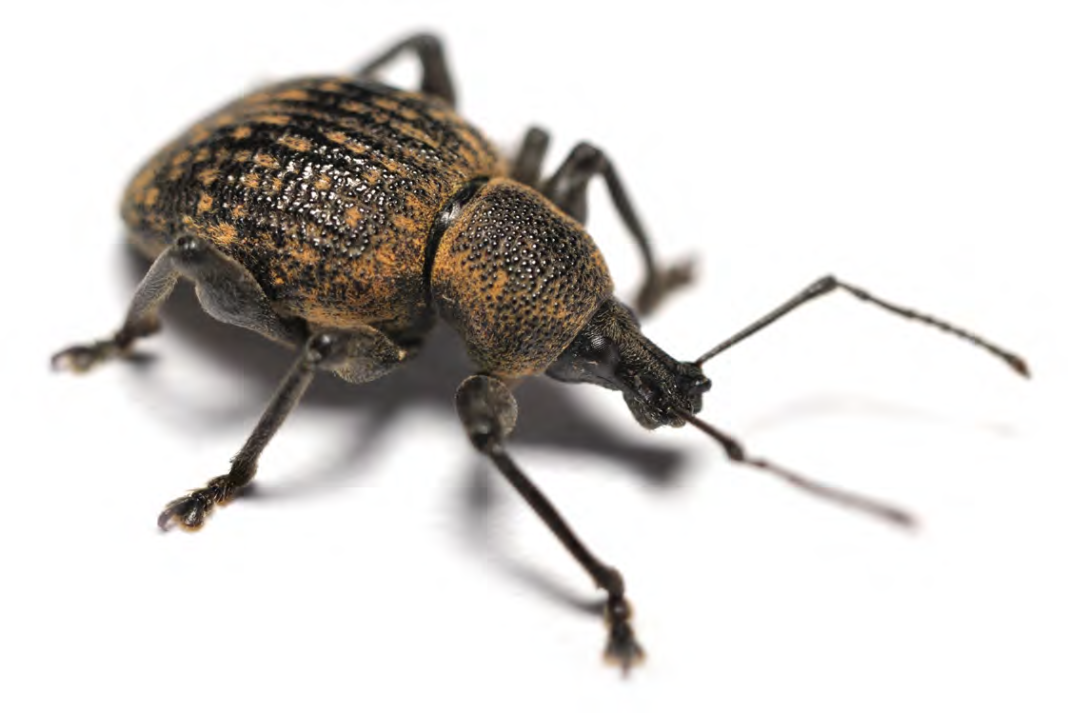Entomologist and IPM researcher, Dr. Michael Gaffney puts the problematic vine weevil under the microscope and details just how research he is conducting at Teagasc Ashtown is making a positive impact
Optimum black vine weevil control is a continuing problem in Irish nurseries. All growers are familiar with the characteristic feeding notches on the edge of leaves or characteristic wilting of plants whose root systems have been eaten by larvae. In the last decade, the majority of soft fruit production and an increasing proportion of nursery stock has migrated from outdoors to under some form of protection, which has meant that the once predictable life stage timings of this insect are becoming less predictable. Ten years ago, we would have expected adults to emerge in May and June, spend between 8 to 10 weeks feeding heavily as their ovaries mature and then commence egg laying from the end of July till the end of September, with egg laying decreasing and adult mortality increasing as temperatures begin to fall. Each adult is female and capable of laying over 1,000 self-fertilized eggs. Changes towards using peat and coir based growing media instead of soil has meant that a greater proportion of the eggs laid will survive to adulthood, and research conducted at Teagasc would indicate that between a 40 and 75% more larvae die from natural causes in soil than in a peat growing media. Today it is quite common to be able to locate all stages of the vine weevil lifecycle (egg, larvae, pupae and adult) in a protected nursery, and finding egg-laying adults in December and January is now not uncommon.
As growing technologies and the vine weevil itself change and adapt, then so too must control strategies change. Integrated Pest Management (IPM) is the cornerstone of the Sustainable Use of Pesticides directive, which came into being in January this year. This means that growers must use multiple (cultural, biological and chemical) approaches to pest and disease control. In terms of vine weevil control, there are many approaches that can dramatically decrease vine weevil problems in a nursery. The dumping of old growing media and grow bags should be done as far away as possible from the nursery. An adult weevil can walk up to 200m in a night, so once an adult emerges from discarded growing media it can find its way back into the nursery particularly as, although they are very polyphagous, they have also been shown to have strong preference for plant species such as Strawberry, Euonymus and Taxus and will choose these species over other available and closer plants. Monitoring for vine weevil can be useful in establishing if you have a large population of adults. This can be done by turning a golf umbrella upside down and brushing or shaking a plant and observing what falls into the umbrella. This can be difficult in strawberry crops, so painting pieces of wood white and placing them flat in the crop will provide a day refuge for adults which can be checked during the day. Vine weevil are attracted to the colour white and this increases the effectiveness of the monitoring.
“Vine weevil control has largely been focused on the control of the larvae”
Ongoing research in Teagasc is assessing the effectiveness of new and existing biocontrol agents for control of vine weevil larvae. To date, we have found that control using entomopathogenic (insect-killing) nematodes (EPNs) to be very effective, with control rates of over 85%, which was equal to and in many cases superior to control offered by both imidacloprid and chlorpyrifos based insecticides, which were previously used to control vine weevil larvae. While some of the EPN products are labelled as cold tolerant our work would indicate that average day temperature should still be considered when deciding on application timings, as a September application (average temperature of 14.1oC seven days post application) increased efficacy 21% over an October application (average temperature of 9.3oC seven days post application). Therefore, while effective, the use of EPNs is dependent on proper timings and application. To help combat the issues with timings, products based on entomopathogenic fungi (EPFs), particularly Metarhizium species are now available. The benefit of using a product like this which can be incorporated at activity, as the control agent is always present. Our experiments showed control of larvae between 60 and 75%, with control at the higher end coming from experiments conducted under glass and plastic. Interestingly, a three-year experiment on outdoor potted Euonymus showed 60% control of larvae 24 months after incorporation, displaying a good level of effective persistence. Nursery scale experiments using both products together gave very high levels of larval control (+95%). However, such a strategy may not be cost effective for a lot of crops. A combination of half rate application of both products gave over 85% control of larvae and may be an option for growers whose crop would benefit from having season long vine weevil larval control.
Vine weevil control has largely been focused on the control of the larvae. However, if you could limit the number of eggs laid, then you can limit the damage caused by the larvae. Azadirachtin is a chemical extracted from the neem tree kernel, which has recently been registered in the European Union. This naturally occurring chemical has been part of insect resistance management strategies in cotton and tobacco crops in the US and has also been used against Colorado potato beetle in Germany. Euonymus foliage in Kinsealy was treated with azadirachtin at different concentrations and fed to adult vine weevils who were about to commence egg laying. At very low concentrations of application of azadirachtin (50 ppm), egg-laying fell to about 10 to 15% of that of the untreated adults. When azadirachtin concentration was increased to 100 ppm egg laying ceased. There was no increase in vine weevil adult mortality in the treated groups compared to the untreated groups, indicating that the chemical was not killing the adults, only affecting their reproduction. Therefore if no eggs are laid then the plant is protected from larval damage. In many crops, such as strawberry the damage caused by adult vine weevil feeding is not important, however for growers of ornamentals where such damage is important this may not be an appropriate strategy as adults will continue to feed on treated foliage. Literature would indicate that azadirachtin applied at these low rates would have little to no environmental impact and is an example of the new strategies for pest and disease management, which legislation such as the SUD looks to foster and promote.
The application of IPM strategies for all pest and disease issues in all crops will be a huge undertaking for growers, advisors, researchers and everyone else involved in growing crops. In the mid-1990s 30% of all insecticides applied on British nurseries were done so to control vine weevil and within 10 years this had been largely replaced by entomopathogenic nematodes. This is a good example of how, if growers are given effective tools, they will adopt new practices very quickly and very successfully. The Sustainable Use of Pesticides directive is an opportunity for Irish growers to highlight the range of IPM friendly approaches already widely used in Ireland and is a challenge for the research and advisory community to continue to provide them with these tools. ✽
  |








